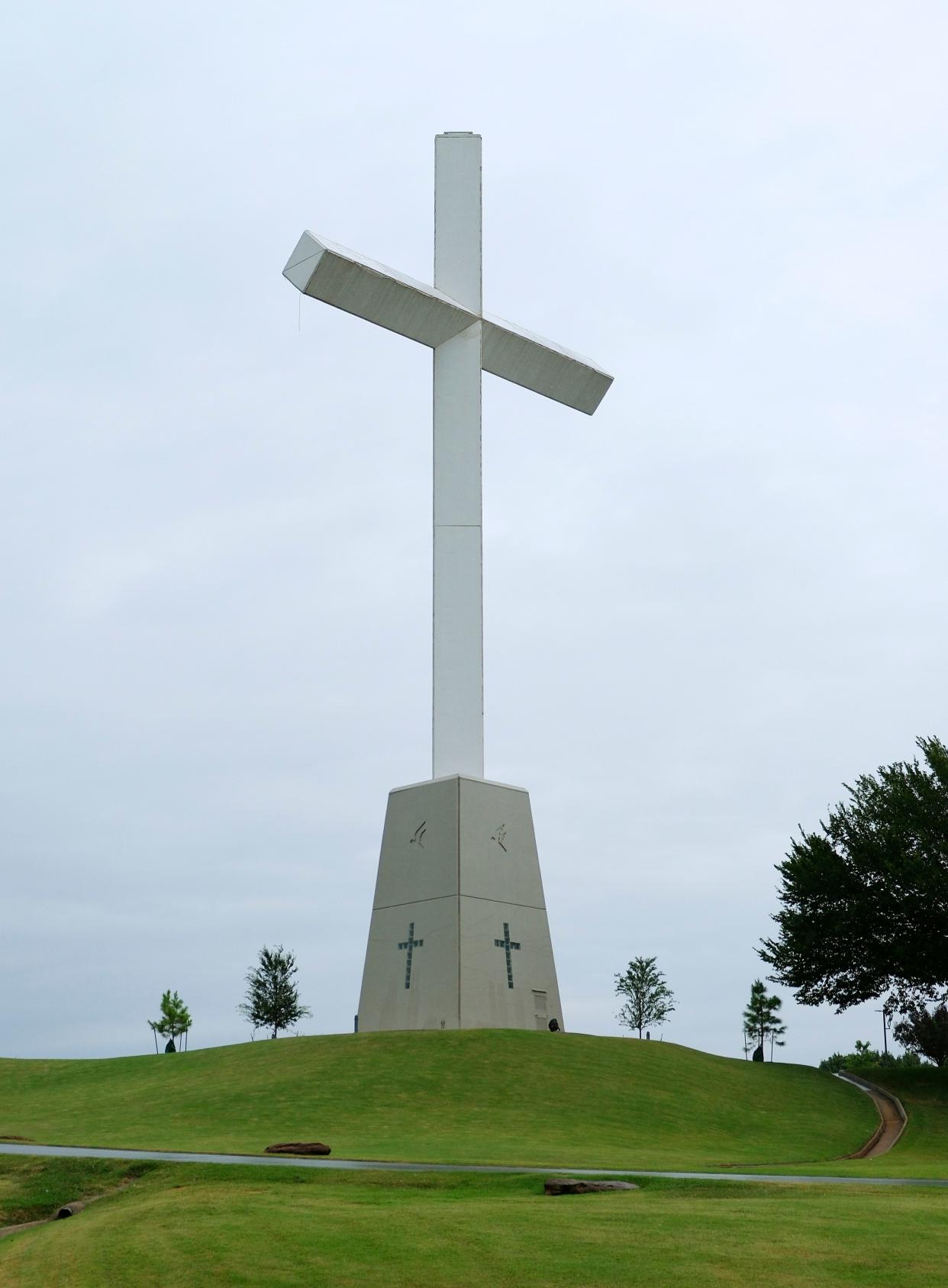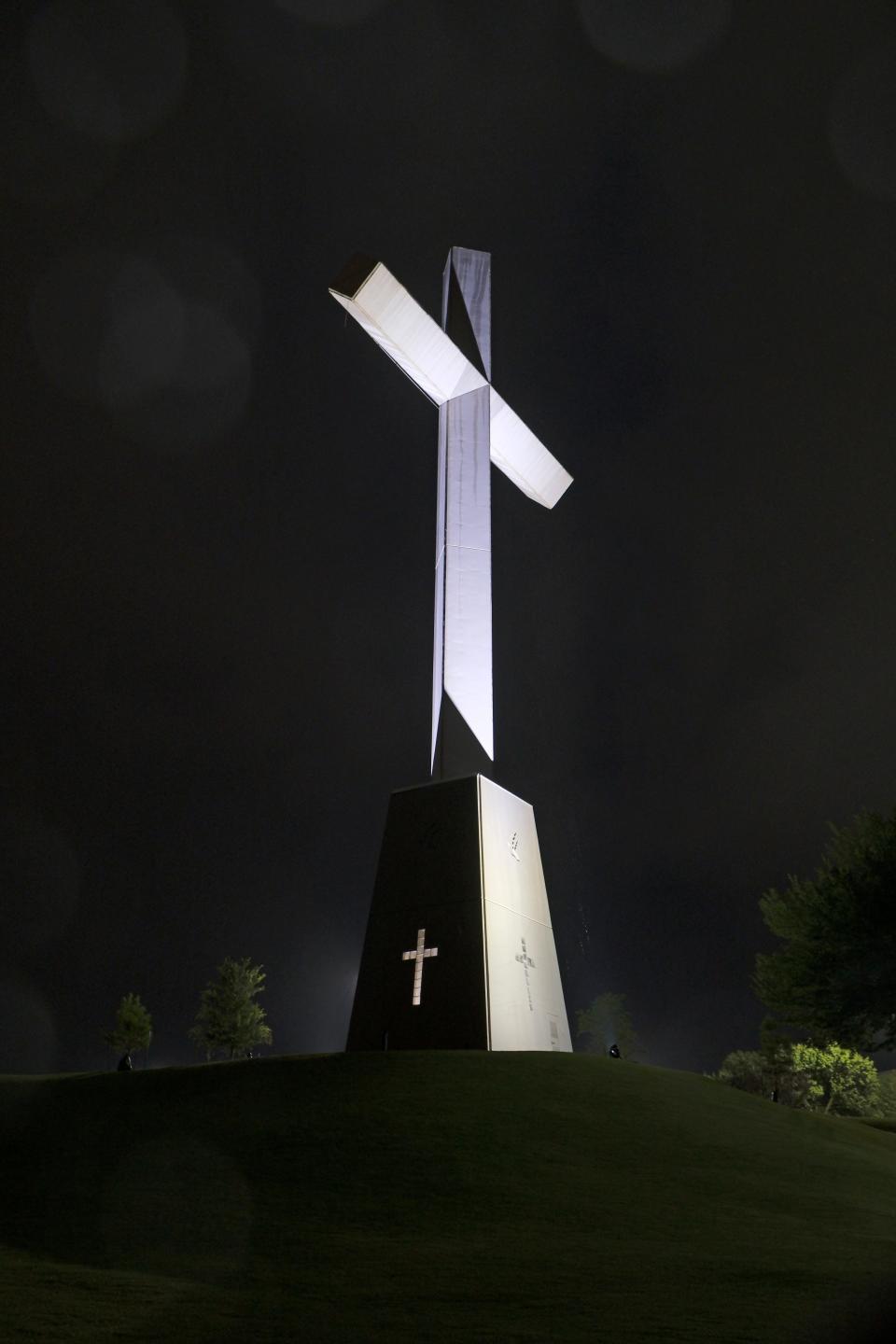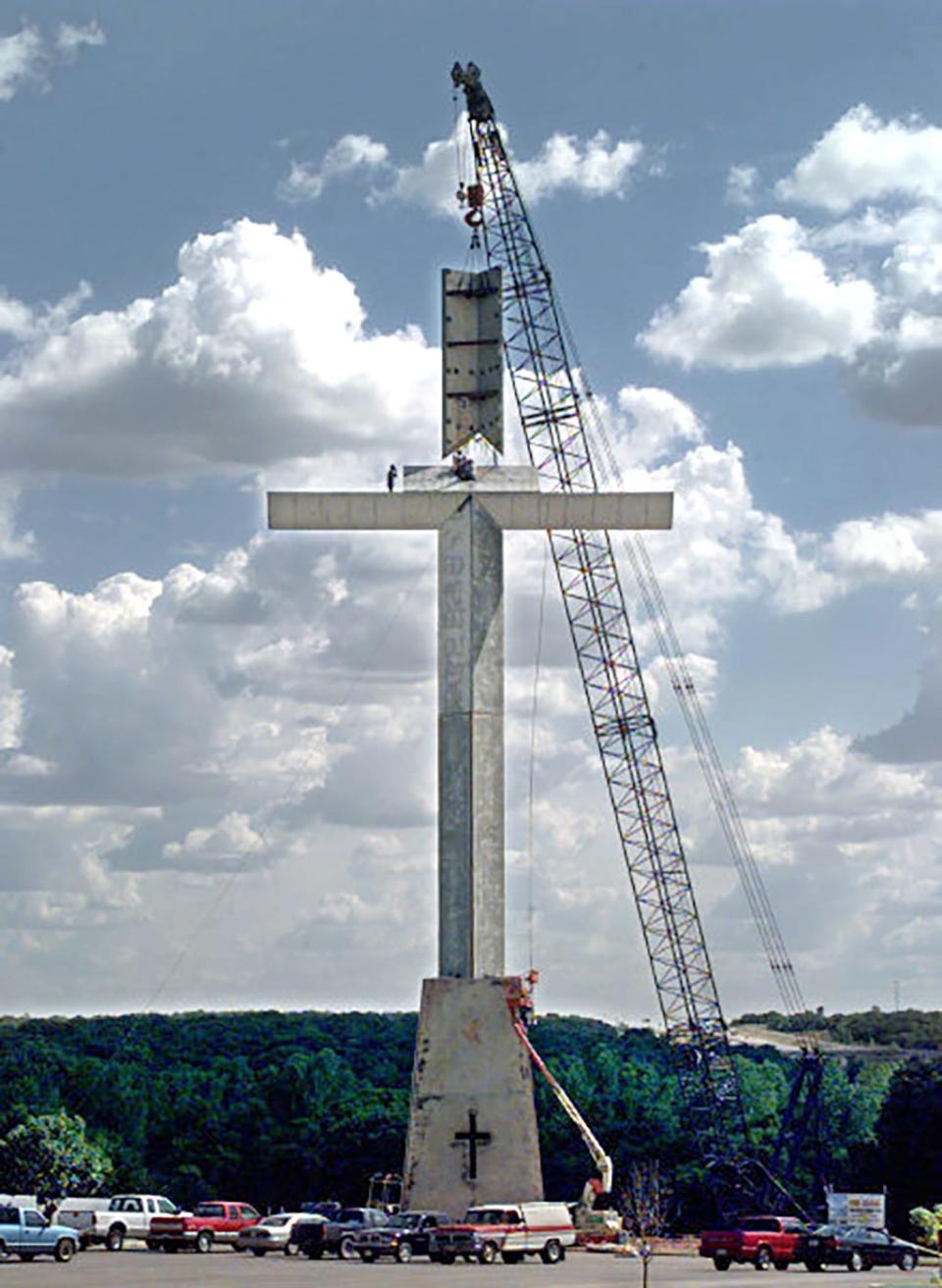A crab, a legal fight, and a vision: How Edmond's giant cross became a reality 25 years ago

The 137-foot-tall cross on the southeast corner of Interstate 35 and Second Street in Edmond is a familiar landmark, but even more interesting than its enormous presence is the story behind efforts to get it built.
Much drama surrounded the plan and eventual placement of the cross on the high-profile I-35 suburban corridor. According to some reports, the idea for the cross was derived, in part, from a court decision about the Edmond city seal. The cross tower proposal was debated by residents who packed into Edmond City Council chambers hoping to declare their support or opposition.
A business proposed signage featuring a giant crab, which would have been on the west side of the interstate just opposite of the cross tower built on the eastside. A temporary injunction was filed in the hopes that the tower's construction would be prevented
Through it all, the cross tower's visionaries were determined to see this giant version of one of the most widely recognized symbols of Christianity come to fruition.
As it happens, the cross was dedicated 25 years ago on property that belonged at that time to MetroChurch, which merged with Edmond-based Life.Church in 2001. The cross is currently a highly visible symbol on property that includes the headquarters of the Life.Church Edmond satellite.
What's the story behind this giant symbol that has become a landmark over more than two decades?
How the giant cross in Edmond became a reality
There is some debate about why MetroChurch began its years-long push for the giant cross. The Oklahoman reported that the cross was the vision of MetroChurch leaders, who thought it would be fitting to place the prominent Christian faith symbol in Edmond particularly after a cross on the Edmond city seal had to be removed.
Edmond city officials had fought to keep the white cross on the seal, but the 10th Circuit Court of Appeals ruled in favor of Wayne Robinson, then pastor of Edmond's Channing Unitarian Universalist Church, along with three members of that church and a Jewish resident who filed a lawsuit to have it removed. When the U.S. Supreme Court refused to take up the city of Edmond's appeal in May 1996, the circuit court's ruling against the city prevailed.
Attorneys for Edmond had argued that the cross represented the historical significance of early churches in Edmond and made note that St. John the Baptist Catholic Church in Edmond had been the first church established in the Oklahoma Territory after the Land Run. The city's attorneys said the seal did not promote religion, but the 10th Circuit court ruled that the cross violated the establishment clause of the First Amendment, which prohibits government from establishing or endorsing religion.
More: Edmond has a giant cross, could it now get a giant Wiley Post statue?
In October 1996, the Rev. Jim Hylton, then MetroChurch's senior pastor, told a reporter that the city of Edmond's unsuccessful fight to keep the cross on its city seal inspired plans for the giant cross.
"It's a certified symbol of Christianity," Hylton said at the time.
The minister also said the church was proposing to install the cross because of interest being generated by another giant cross near Groom, Texas, in the Texas Panhandle.
At the time it was proposed, MetroChurch leaders said the cross would be visible about two miles from the north, three miles from the south and two miles from east and west, joining water towers in distinguishing Edmond's skyline, according to reports.

Recently, the Rev. Ernest Frank Parrish, 67, who served as MetroChurch administrative pastor and children's pastor, said the matter of the city seal wasn't that much of a catalyst for the giant cross proposal. Instead, he said the church's plans had more to do with the huge cross in the Texas Panhandle.
News reports at the time said the idea for the cross came from MetroChurch member Steve Quillin. During a recent interview, Parrish said he remembered that Calvin Burgess, one of MetroChurch's elders, played an integral role in the cross proposal because he had heard about the giant cross on Interstate 40 in Texas. And Parrish said Canam Construction of Edmond, owned by Burgess, went on to build the cross and the tower that would serve as its base.
Burgess, 72, who currently lives near Paris, Texas, said Hylton, who is deceased, liked the proposal and once plans were drawn up, he and the pastor took them to the Edmond City Council.
They didn't foresee resistance to their plans.
Edmond City Council was not initially on board with giant cross
The church was required to apply for a special-use permit for the cross. The application had to go through the Edmond Planning Commission and ultimately be approved by the Edmond City Council.
Parrish said he remembered that the church's elders were initially excited about the plans to erect the cross.
"They were in unity about it," he said. "It was pretty distressing when the city came out against it. It surprised us ― we really didn't anticipate that."
Burgess agreed.
"We had to go through a lot of battles with the city trying to get a permit for it, which was kind of ridiculous," he said.

The battles he referred to were waged over the fact that structures taller than 35 feet were not allowed along the I-35 corridor without a variance.
The Edmond Planning Commission voted 3-2 against the church's request in December 1996. The commission expressed concern about the height, precedent and land-use issues.
About a dozen people spoke in favor of the cross and half a dozen spoke against it, with supporters predicting it would be a "unique landmark" and a "jewel," and opponents calling it "disrespectful," "offensive" and setting a "bad precedent."
A planning commissioner said the church's application put city officials in "an awkward position," according to The Oklahoman.
"There are ways to express one's faith without putting the community in the position we have been put into tonight," he said.
Another commisioner said it all boiled down to a "a sign issue, not a religion issue."
The Edmond City Council voted 3-2 against the cross plan. News reports said about 100 people crowded into Edmond City Hall, and some of the discussion with council members focused on whether the cross was a sign, a structure or a symbol.
MetroChurch leaders said they would consider scaling down their cross tower, but they had every intention of bringing the matter back to the city for another vote.
Attorney Randel Shadid served as Edmond Ward 1 councilman for 16 years, and Edmond mayor from 1991 to 1995. He said he had vivid memories of the cross tower effort — particularly because he was the attorney representing an Edmond businessman who opposed it.
The cross and the crab
In 1997, MetroChurch applied again to build the cross tower.
This time, the city council voted 3-2 to grant the necessary special-use permit. City planners said that although the cross was planned in a zoning district restricting most structures to 35 feet, an exception could be granted to church buildings that are set back more than half their height from neighboring properties.
Enter Shadid, who filed a temporary injunction against the city of Edmond, asking a judge to halt construction of the cross while determining whether the project was legal under city ordinances. Shadid represented Sellers Crab and Steak House, whose application for a 137-foot-tall crab sign on the west side of I-35 had been denied by the Edmond City Council.
In a recent interview, Shadid said he had objected to the city council's approval of the church's cross tower, and he wasn't the only one. He said he is a Christian, but he believed that "you live your faith" instead of "cramming" faith signage like a giant cross along an interstate on others.
Shadid said he and his client, a Jewish landowner, applied for a special-use permit for the crab sign to prove a point.
More: Edmond nature preserve a step closer to reality following conservation agreement
"He asked me to represent him to do two things," the attorney said. "One was to prevent the cross because it was a violation of height restrictions and sign code ordinances. And Number Two, if they were entitled to that, he wanted to do a sign advertising his restaurant."
Ultimately, a judge did not grant a temporary injunction barring MetroChurch from building the cross tower. And Shadid said he and his client didn't pursue the case for the crab sign. He said the sign would have been expensive ― costing about $250,000 ― and while it would have been a nice addition to the I-35 corridor, it wasn't a proposal they were willing push.
"I believe that it (cross tower) was a sign which violated the city's existing ordinances and it was too tall under the city's height ordinances on that section of I-35," he said. "And personally, I believe it was an offense to any non-Christian to have that shoved in their face every time they drive by that intersection on Highway 66 and (I-)35."
The attorney emphasized that this was his personal opinion and not a legal opinion, but it fueled his decision to argue for the proposed crab sign.
"I took the case for my Jewish friend, and I never charged him. I said 'I'll do this. It'll be fun' ― and it was," Shadid said.
'It was a celebration'
The height of MetroChurch's cross tower was ultimately shortened by 20 feet from the original proposal. While the original design called for a 100-foot-tall cross atop a 57-foot-tall base, the new design called for a 100-foot-tall cross lighted by fiber optics on a 37-foot-tall base, both made of white, precast concrete. MetroChurch leaders told reporters that the estimated $500,000 project was paid for by members' donations and others who supported the effort.
The cross tower was finally dedicated in fall 1998, and MetroChurch members were elated.
"It was a celebration — big time," Parrish said.
He said the cross is exactly what the church had envisioned.
"It has truly become a landmark," the minister said.
LaRue McDaniel, of Edmond, said she and her husband, Bob, attended MetroChurch when church leaders first requested a permit to build the cross. She said they left the church before the cross was dedicated, but that didn't mean they weren't pleased to see the dream for the symbolic structure become a reality.
"Everytime we go by it, it's just wonderful and heartwarming to us," she said.
Meanwhile, Sam Marin, Life.Church Edmond campus pastor, said the cross continues to signify hope and to draw passersby to the church adjacent to it.
"While Metro Church built the cross years before this location became Life.Church, the cross has continued to be a symbol of hope for so many people," he said.
"In fact, someone recently told me he would drive by the cross every day on his way to work during one of the darkest times of his life. One day he finally thought, I should go in there.' He came in and that was the beginning of his life being transformed. It’s been an honor to pastor and care for people like him who we might not have ever met if they weren't drawn to the cross."
Burgess said he quickly realized that the cross is a well-known landmark on Route 66. He said he also knows that Edmond has become known as the "city with the cross."
He shared memories of visiting with Ed Sturm, the engineer who designed the cross tower. One of Sturm's remarks stood out as funny and poignant to Burgess after he teased the engineer about the sturdiness of the cross.
"I said 'Ed, we get tornadoes around here ― there's no chance that cross could come down?'" Burgess said.
"He said 'Let me tell you what, Calvin, if it comes down, it was because God took it down. Otherwise, it's there forever."
This article originally appeared on Oklahoman: How the giant cross in Edmond Oklahoma on I-35 became a reality

